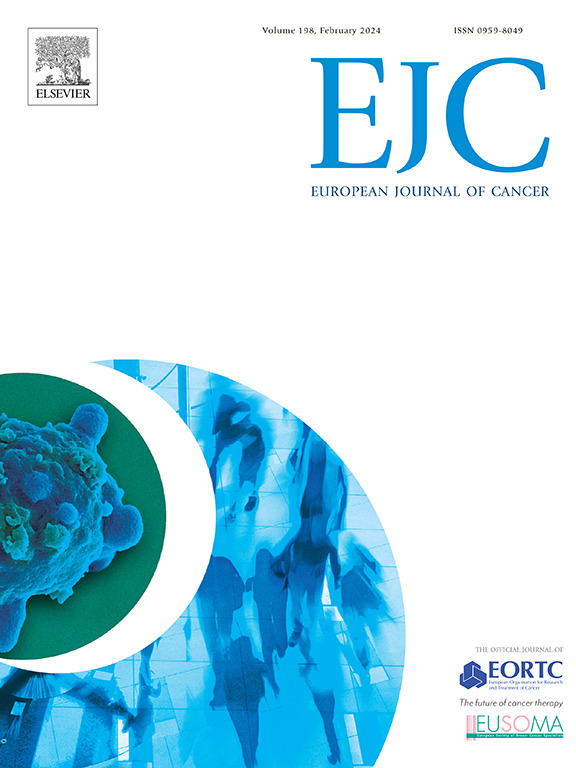纳武单抗和伊匹单抗联合免疫治疗伴或不伴序或伴立体定向放疗治疗黑色素瘤脑转移患者:一项国际回顾性研究
IF 7.6
1区 医学
Q1 ONCOLOGY
引用次数: 0
摘要
dipilimumab + nivolumab (COMBO)是无症状黑色素瘤脑转移(MBM)患者的标准治疗方法。我们报告了一项回顾性研究,旨在评估MBM患者接受COMBO治疗合并或不合并顺序/同步立体定向放疗(SRT)的结果。方法对合并或不合并SRT的smbm患者进行统计学分析、类固醇治疗、中枢神经系统(CNS)相关症状、BRAF状态、放疗(是否和时间)或手术、MBM数量、最大转移直径、总有效率(ORR)、无进展(PFS)和总生存期(OS)。结果纳入453例患者:单独接受COMBO治疗190例,COMBO联合SRT治疗107例,COMBO联合SRT治疗156例。在多变量分析中,基线时的治疗线[>; 1 vs 1: HR 2.60(1.93-3.50)]、顺序SRT vs未放疗[HR 0.45(0.32-0.64)]、合并SRT vs未放疗[HR 0.48(0.33-0.69)]、类固醇[HR 1.56(1.17-2.08)]、年龄[HR 1.01(1.00-1.02)]和MBM数量[≥ 3 vs 1 HR 1.55(1.11-2.17))、2 vs 1 HR 1.53(1.02-2.31)]与OS相关。同时接受SRT和顺序SRT的患者之间没有显著差异。在中位随访29个月时,总体人群的中位os为17.8个月,而接受顺序放疗的SRT患者的中位os为27.3个月(15.3-39.4个月),接受联合放疗的放疗患者的中位os为22.2个月(12.7-31.7个月)。放射性坏死的发生率为10.3% %。毒性与先前的研究一致。结论sour结果表明,无论SRT的时间如何,接受SRT + COMBO的患者有更好的OS。需要前瞻性研究来验证我们的发现。本文章由计算机程序翻译,如有差异,请以英文原文为准。
Combined immunotherapy with nivolumab and ipilimumab with and without sequential or concomitant stereotactic radiotherapy in patients with melanoma brain metastasis: An international retrospective study
Background
Ipilimumab plus nivolumab (COMBO) is the standard treatment in patients with asymptomatic melanoma brain metastases (MBM). We report a retrospective study aiming to assess the outcome of patients with MBM treated with COMBO with or without sequential/concomitant stereotactic radiotherapy (SRT).
Methods
MBM patients treated with COMBO with or without SRT have been retrieved: demographics, steroid treatment, Central Nervous System [CNS]-related symptoms, BRAF status, radiotherapy (yes/no and timing) or surgery, number of MBM, maximum diameter of metastasis, overall response rate (ORR), progression-free (PFS) and overall survival (OS) have been analyzed.
Results
453 patients were included: 190 received COMBO alone, 107 received COMBO and concomitant SRT, 156 COMBO and sequential SRT, respectively. At multivariable analysis the line of treatment [> 1st vs 1st: HR 2.60 (1.93–3.50)], sequential SRT vs no radiotherapy [HR 0.45 (0.32–0.64)], concomitant SRT vs no radiotherapy [HR 0.48 (0.33–0.69)], steroids [HR 1.56 (1.17–2.08)], age [HR 1.01 (1.00–1.02)] and number of MBM [≥ 3 vs 1 HR 1.55 (1.11–2.17)), 2 vs 1 HR 1.53 (1.02–2.31)] at baseline were associated with OS.
There was no significant difference between patients who received concomitant vs sequential SRT. At a median follow-up of 29 months, the median-OS in the overall population was 17.8 months while in those who received SRT was 27.3 (15.3–39.4) for patients receiving sequential radiotherapy and 22.2 (12.7–31.7) for those receiving radiotherapy concomitantly to COMBO. The incidence of radionecrosis was 10.3 %. Toxicities were consistent with previous studies.
Conclusions
Our results suggest a better OS in patients who receive SRT plus COMBO, regardless of timing of SRT. Prospective studies are needed to validate our findings.
求助全文
通过发布文献求助,成功后即可免费获取论文全文。
去求助
来源期刊

European Journal of Cancer
医学-肿瘤学
CiteScore
11.50
自引率
4.80%
发文量
953
审稿时长
23 days
期刊介绍:
The European Journal of Cancer (EJC) serves as a comprehensive platform integrating preclinical, digital, translational, and clinical research across the spectrum of cancer. From epidemiology, carcinogenesis, and biology to groundbreaking innovations in cancer treatment and patient care, the journal covers a wide array of topics. We publish original research, reviews, previews, editorial comments, and correspondence, fostering dialogue and advancement in the fight against cancer. Join us in our mission to drive progress and improve outcomes in cancer research and patient care.
 求助内容:
求助内容: 应助结果提醒方式:
应助结果提醒方式:


